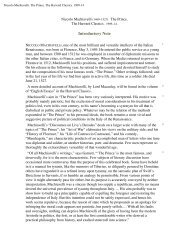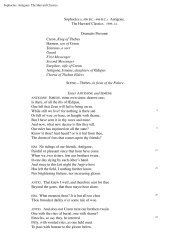Notre Dame de Paris - Bartleby.com
Notre Dame de Paris - Bartleby.com
Notre Dame de Paris - Bartleby.com
You also want an ePaper? Increase the reach of your titles
YUMPU automatically turns print PDFs into web optimized ePapers that Google loves.
listening to. In general, the murmur that rises up from <strong>Paris</strong> during the daytime is the city talking; at night<br />
it is the city breathing; but this is the city singing. Lend your ear, then, to this tutti of the bells; diffuse<br />
over the ensemble the murmur of half a million of human beings, the eternal plaint of the river, the<br />
ceaseless rushing of the wind, the solemn and distant quartet of the four forests set upon the hills, round<br />
the horizon, like so many enormous organ-cases; muffle in this, as in a sort of twilight, all of the great<br />
central peal that might otherwise be too hoarse or too shrill, and then say whether you know of anything<br />
in the world more rich, more blithe, more gol<strong>de</strong>n, more dazzling, than this tumult of bells and<br />
chimes—this furnace of music, these ten thousand brazen voices singing at once in flutes of stone, three<br />
hundred feet high—this city which is now but one vast orchestra—this symphony with the mighty uproar<br />
of a tempest.<br />
Book IV<br />
I. Charitable Souls<br />
SIXTEEN years before the events here recor<strong>de</strong>d took place early on Quasimodo or Low-Sunday<br />
morning, a human creature had been <strong>de</strong>posited after Mass on the plank bed fastened to the pavement on<br />
the left of the entrance to <strong>Notre</strong> <strong>Dame</strong>, opposite the “great image” of Saint Christopher, which the<br />
kneeling stone figure of Messire Antoine <strong>de</strong>s Essarts, knight, had contemplated since 1413. Upon this<br />
bed it was customary to expose foundling children to the charity of the public; any one could take them<br />
away who chose. In front of the bed was a copper basin for the reception of alms.<br />
The specimen of humanity lying on this plank on the morning of Quasimodo-Sunday, in the year of our<br />
Lord 1467, seemed to invite, in a high <strong>de</strong>gree, the curiosity of the very consi<strong>de</strong>rable crowd which had<br />
collected round it. This crowd was largely <strong>com</strong>posed of members of the fair sex; in fact, there were<br />
hardly any but old women.<br />
In front of the row of spectators, stooping low over the bed, were four of them whom by their gray<br />
cagoules—a kind of hoo<strong>de</strong>d cassock—one recognised as belonging to some religious or<strong>de</strong>r. I see no<br />
reason why history should not hand down to posterity the names of these discreet and venerable dames.<br />
They were: Agnès la Herme, Jehanne <strong>de</strong> la Tarme, Henriette la Gaultière, and Gauchére la Violette—all<br />
four widows, all four be<strong>de</strong>s-women of the Chapelle Etienne-Haudry, who, with their superior’s<br />
permission, and conformably to the rules of Pierre d’Ailly, had <strong>com</strong>e to hear the sermon.<br />
However, if these good sisters were observing for the moment the rules of Pierre d’Ailly, they were<br />
certainly violating to their heart’s content those of Michel <strong>de</strong> Brache and the Cardinal of Pisa, which so<br />
inhumanly imposed silence upon them.<br />
“What can that be, sister?” said Agnès la Herme as she gazed at the little foundling, screaming and<br />
wriggling on its woo<strong>de</strong>n pallet, terrified by all these staring eyes.<br />
“What are we <strong>com</strong>ing to,” said Jehanne, “if this is the kind of children they bring into the world now?”<br />
“I am no great judge of children,” resumed Agnès, “but it must surely be a sin to look at such a one as<br />
this.”<br />
“It’s not a child, Agnès.”










